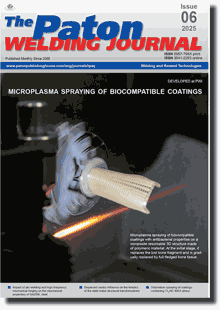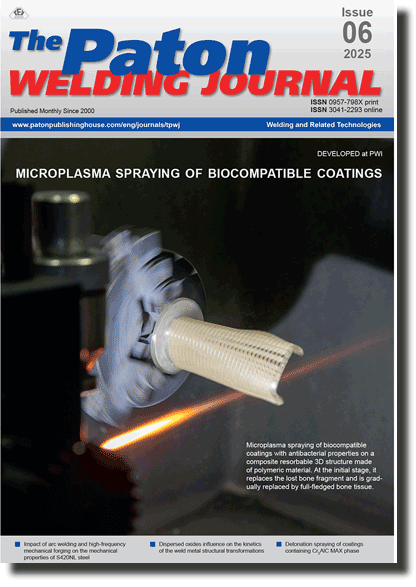| 2025 №06 (01) |
DOI of Article 10.37434/tpwj2025.06.02 |
2025 №06 (03) |

The Paton Welding Journal, 2025, #6, 9-18 pages
Dispersed oxides influence on the kinetics of the weld metal structural transformations
V.V. Holovko, V.A. Kostin, V.V. Zhukov
E.O. Paton Electric Welding Institute of the NASU. 11 Kazymyr Malevych Str., 03150, Kyiv, Ukraine. E-mail: v_golovko@ukr.netAbstract
Research was conducted to study the influence of inoculation of the aluminium, titanium, magnesium, and zirconium dispersed refractory oxides into the weld pool on the modification of the metal structure in low-alloy steel welds. It is shown that the inoculation of refractory oxides into the weld pool increases the temperature at which the bainitic transformation ends and significantly reduces its temperature range. This trend coincides with the size of the wetting angle between the oxide and liquid iron. Increasing the content of inoculants in the weld pool liquid metal from 0.1 to 0.2 % affects the temperatures of the start and finish of the bainitic transformation. Both the start and finish temperatures are increased, that is, the formation of bainite occurs in the higher temperatures region, and the temperature range of this region narrows (the kinetics of transformation increases). An increase in the temperature of the finish of the bainitic transformation and a reduction in its temperature range cause an increase in the acicular ferrite content in the weld metal structure, which corresponds to an increased impact energy level of the weld metal.
Keywords: welding, microstructure, dispersed oxides, weld pool inoculation, bainitic transformation
Received: 31.10.2024
Received in revised form: 19.03.2025
Accepted: 25.06.2025
References
1. Gubenko, S.I., Parusov, V.V., Derevyanchenko, I.V. (2005) Nonmetallic inclusions in steel. Dnipro, ART-PRESS [in Russian].2. Goldstein, Ya.E., Mizin, V.G. (1956) Modification and microalloying of cast iron and steel. Moscow, Metallurgiya [in Russian].
3. Shpis, H.-I. (1971) Behavior of nonmetallic inclusions in steel during crystallization and deformation. Moscow, Metallurgiya [in Russian].
4. Popovich, V., Kondir, A., Pleshakov, E. et al. (2009) Technology of structural materials and materials science. Practical work. Lviv, Svit [in Ukrainian].
5. Bokshtejn, B.S., Kopetsky, I.V., Shvindlerman, L.S. (1986) Thermodynamics and kinetics of grain boundaries in metals. Moscow, Metallurgiya [in Russian].
6. Gulyaev, A.P. (1977) Metals science. Moscow, Metallurgiya [in Russian].
7. Rohrer, G.S. (2011) Grain boundary energy anisotropy: A review. J. Mater. Sci., 46, 5881-5895. https://doi.org/10.1007/s10853-011-5677-3
8. Rohrer, G.S., Anthony, J.G., Rollett, E.D. (2008) A model for the origin of anisotropic grain boundary character distributions in polycrystalline materials. Applications of Texture Analysis, 17, 10. https://doi.org/10.1002/9780470444214.ch36
9. Panasyuk, A.D., Fomenko, V.S., Glebova, H.G. (1986) Stability of nonmetallic materials in melts. Kyiv, Naukova Dumka [in Russian].
10. ISO 14171:2008(E): Welding consumables — Wire electrodes and wire-flux combinations for submerged arc welding of non alloy and fine grain steels — Classification.
11. ISO 17639:2003: Destructive tests on welds in metallic materials — Macroscopic and microscopic examination of welds.
12. IIW Doc. No. lX-1533-88/IXJ-123-87 Revision 2 / June 1988 Guide to the light microscope examination of ferritic steel weld metals.
Suggested Citation
V.V. Holovko, V.A. Kostin, V.V. Zhukov (2025) Dispersed oxides influence on the kinetics of the weld metal structural transformations. The Paton Welding J., 06, 9-18.The cost of subscription/purchase order journals or individual articles
| Journal/Currency | Annual Set | 1 issue printed |
1 issue |
one article |
| TPWJ/USD | 384 $ | 32 $ | 26 $ | 13 $ |
| TPWJ/EUR | 348 € | 29 € | 24 € | 12 € |
| TPWJ/UAH | 7200 UAH | 600 UAH | 600 UAH | 280 UAH |
| AS/UAH | 1800 UAH | 300 UAH | 300 UAH | 150 UAH |
| AS/USD | 192 $ | 32 $ | 26 $ | 13 $ |
| AS/EUR | 180 € | 30 € | 25 € | 12 € |
| SEM/UAH | 1200 UAH | 300 UAH | 300 UAH | 150 UAH |
| SEM/USD | 128 $ | 32 $ | 26 $ | 13 $ |
| SEM/EUR | 120 € | 30 € | 25 € | 12 € |
| TDNK/UAH | 1200 UAH | 300 UAH | 300 UAH | 150 UAH |
| TDNK/USD | 128 $ | 32 $ | 26 $ | 13 $ |
| TDNK/EUR | 120 € | 30 € | 25 € | 15 € |
AS = «Automatic Welding» - 6 issues per year;
TPWJ = «PATON WELDING JOURNAL» - 12 issues per year;
SEM = «Electrometallurgy Today» - 4 issues per year;
TDNK = «Technical Diagnostics and Non-Destructive Testing» - 4 issues per year.


